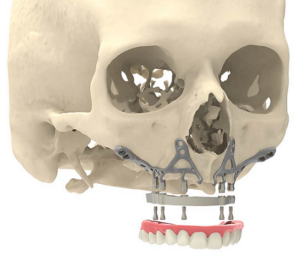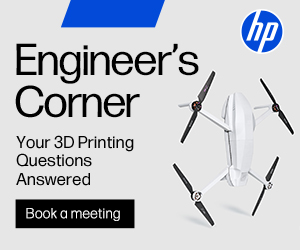3D Design and 3D Printing Enhance Creation of Patient-Specific Titanium Jaw Implants
 While we’ve seen 3D printed medical implants made out of materials like silicone and cobalt chromium, the most common metal of choice is titanium due to its low density and high strength. Titanium has been used many times to fabricate 3D printed jaw implants, which is the specialty of medical device startup CADskills, based in Belgium. The startup focuses on patient-specific implants for craniomaxillofacial (CMF) and neurosurgery patients, including its innovative AMSJI, a new generation of subperiosteal implant. AMSJI stands for Additively Manufactured Subperiosteal Jaw Implant (say that five times fast), and as highlighted in a recent case study, this 3D printed titanium jaw implant can make life much better for people who suffer from extreme maxillary atrophy.
While we’ve seen 3D printed medical implants made out of materials like silicone and cobalt chromium, the most common metal of choice is titanium due to its low density and high strength. Titanium has been used many times to fabricate 3D printed jaw implants, which is the specialty of medical device startup CADskills, based in Belgium. The startup focuses on patient-specific implants for craniomaxillofacial (CMF) and neurosurgery patients, including its innovative AMSJI, a new generation of subperiosteal implant. AMSJI stands for Additively Manufactured Subperiosteal Jaw Implant (say that five times fast), and as highlighted in a recent case study, this 3D printed titanium jaw implant can make life much better for people who suffer from extreme maxillary atrophy.
The customizable AMSJI offers a new alternative for these patients, eliminating the bone grafting process and its months of recovery time. Surgery with the AMSJI only takes an hour, so the patient is out of the operating room with fixed teeth the same day.
 Prof. Mommaerts with the University of Brussels came up with the idea for the AMSJI, and the original versions were made out of stiff cobalt-chrome alloy material, which didn’t have much in the way of bone ingrowth properties. Titanium was chosen for its conductivity, bone ingrowth, and biocompatibility, and it’s fixed with screws to offer stability. By 3D printing the implant, the process is easier to control, and there are many more design possibilities, including the option to add porous structures.
Prof. Mommaerts with the University of Brussels came up with the idea for the AMSJI, and the original versions were made out of stiff cobalt-chrome alloy material, which didn’t have much in the way of bone ingrowth properties. Titanium was chosen for its conductivity, bone ingrowth, and biocompatibility, and it’s fixed with screws to offer stability. By 3D printing the implant, the process is easier to control, and there are many more design possibilities, including the option to add porous structures.
The startup has only been around for a year, but it’s already starting to make some waves – in addition to its AMSJI, CADskills is part of the collaborative Family of the Future effort that was announced just a few weeks ago. CADskills is working to become a leader in patient-specific TMJ implants and subperiosteal implants, and one of its five-year goals is to build a global network of opinion leaders and support surgeons around the AMSJI. Therefore, the startup is being careful to ensure there are no mistakes in its current CMF work.
“For the past year, CADskills has studied each case meticulously and we’ve waited to see how soft tissues around the implant are reacting,” said Robin Detaille, COO at CADskills. “We have been learning from every case and have continuously worked at perfecting the AMSJI’s design for each new patient.”
 CADskills uses the Mimics Innovation Suite (MIS) from Materialise to achieve fast, reliable results for its 3D printed titanium implants. The software suite helps clean up CT scans, so that any additional titanium plates or dental implants that a patient may already have don’t cause scattering, which happens often with normal segmentation software. Implant designs can be imported in Mimics and then positioned properly on a 3D anatomic model, which gives surgeons a better 3D view of exactly how the implant will look with the nerve positioning and surrounding soft tissue.
CADskills uses the Mimics Innovation Suite (MIS) from Materialise to achieve fast, reliable results for its 3D printed titanium implants. The software suite helps clean up CT scans, so that any additional titanium plates or dental implants that a patient may already have don’t cause scattering, which happens often with normal segmentation software. Implant designs can be imported in Mimics and then positioned properly on a 3D anatomic model, which gives surgeons a better 3D view of exactly how the implant will look with the nerve positioning and surrounding soft tissue.
MIS also allows CADskills to import screws and let surgeons know about optimal screw length, and the suite is also certified, which saves time on the administrative side of things. The startup’s favorite MIS feature is its intuitive multiple slice editing functionality, which makes the whole process much faster overall.
“Compared to competitors, MIS’s speed is magnificent. It’s also stable, reliable and certified,” said Ruben van de Sande from CADskills. “The Materialise Mimics support team are fantastic – they are incredibly fast at solving problems and we know we can rely on them. Another upside to MIS is that it’s user friendly which makes it very easy to train new employees to use it.”
CADskills is confident that the clinical results for its AMSJI will be good, and is looking forward to taking the implant to the global marketplace. The startup, which also works with orthopedic patients, is also looking into ways to improve temporo-mandibular joint prostheses and cranial plates, and is thinking about expanding into the veterinary field. As 3D printed titanium implants have already helped in relieving cruciate ligament conditions in dogs, I think the possibilities for success are wide open. Discuss in the CADSkills forum at 3DPB.com.
[Images: Materialise]Subscribe to Our Email Newsletter
Stay up-to-date on all the latest news from the 3D printing industry and receive information and offers from third party vendors.
Print Services
Upload your 3D Models and get them printed quickly and efficiently.
You May Also Like
Ohio Ordnance Works Partners With Velo3D on Metal 3D Printing for Defense Initiative
Metal 3D printing firm Velo3D announced that it has partnered with Ohio Ordnance Works (OOW), a Class III arms manufacturer. The company makes the REAPR machine gun and SAW, BAR,...
Broad Spectrum Additive at the US Air Force
If we look at how Air Forces around the world use additive manufacturing, a lot of the attention is focused on future possibilities in hypersonics and next-generation aircraft. Beyond the...
EOS Releases Medical Device Master File for M290 3D Printer
Laser powder bed fusion (LPBF) firm EOS has released a Medical Device Master File that will make it easier for customers to achieve regulatory success. The file will essentially be...
Push Button Metal 3D Printing for $50,000?
In 2021 we wrote an article about “Push Button Metal, the low cost metal 3D printing evolution we are not talking about.” In it, we talked about One Click Metal,...
































